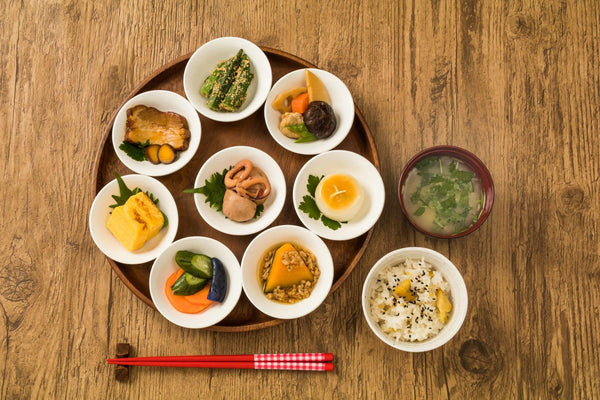
Jump to:
Japan delights us with its vibrant food culture and mouth-watering cuisine.
We marvel at sushi, love the savory notes of ramen and appreciate the full range of Japanese culinary offerings.
What’s more, Japan consistently ranks among the world's healthiest nations.
How can a country known for its delicious food also boast such impressive health statistics? One big clue is the traditional Japanese diet.
In this edition of the Japanese Taste blog, we’ll explore the Japanese diet – what it is, why it's healthy, and how you can weave some of its goodness into your own life.
What Is The Traditional Japanese Diet Like?
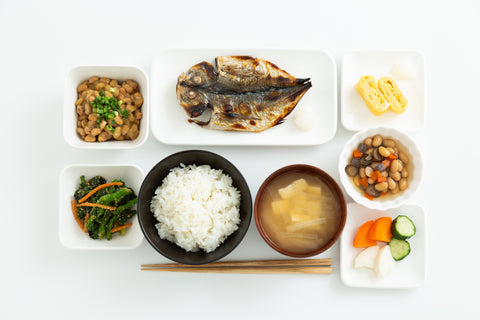
The traditional Japanese diet, generally known as "Washoku," emphasizes fresh, seasonal ingredients, balanced meals and beautiful presentation.
It's a world away from the processed, oversized portions often seen in Western diets. At the heart of washoku lies the concept of balance – a variety of foods in moderate amounts, ensuring that one’s body gets the diverse nutrients it needs.
Think of a typical Japanese meal. You might see a small bowl of steamed rice, a bowl of miso soup with tofu and seaweed, a grilled piece of fish, some simmered vegetables and perhaps a few pickled vegetables on the side.
This type of meal, known as 'ichiju-sansai' (one soup, three sides), exemplifies balance with its mix of carbohydrates, protein, vegetables and fermented foods. The emphasis is on savoring the natural flavors of ingredients. Portion control plays a key role in maintaining a healthy weight.
What Are The Origins & History Of The Japanese Diet?
The Japanese diet has evolved over centuries, shaped by both necessity and philosophy.
Buddhism's influence led to periods of primarily vegetarian and vegan eating, emphasizing respect for all life forms. This is still seen in Japan today, with “shojin ryori” or Buddhist vegan cuisine.
Japan's island geography has also ensured a heavy reliance on seafood over the years, turning fish into a staple protein. While beef, pork and chicken have entered the Japanese diet over the years, fish and seafood still play a major role in Japanese cuisine – and have helped keep the Japanese people healthy.
Throughout its history, the Japanese diet has had times of both scarcity and abundance, teaching generations to appreciate food resourcefully.
While the Japanese diet has modernized, with influences from other cuisines becoming more common, the core principles of freshness, balance and respect for ingredients remain strong. The traditional approach views food as a source of nourishment, not just a means to satisfy hunger.
Japanese Diet Style & Food Staples
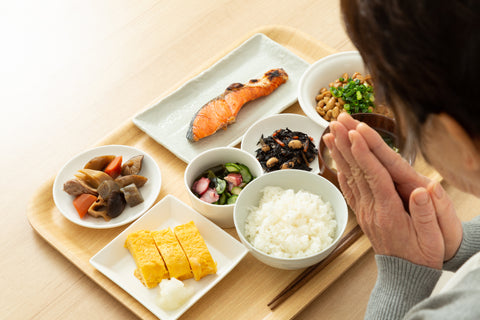
Beyond the nutritional content, the style of eating in Japan is a stark contrast to many Western habits.
Meals in Japan follow the aforementioned "Ichiju-Sansai" principle – one soup and three sides, typically accompanied by rice. Even a quick Japanese breakfast often comprises rice, miso soup, fish and vegetables.
Presentation is given careful attention in Japan. Dishes are often served in individual, aesthetically pleasing portions. This visual appeal encourages mindful eating and appreciation for the food itself. Portion sizes are generally smaller compared to standard Western servings, further contributing to a healthy balance.
Some staples of the Japanese diet include:
- Rice: Short-grain white rice is the foundation, often served steamed and unseasoned.
- Miso Soup: A light broth flavored with miso paste (fermented soybean), often includes tofu, seaweed and vegetables.
- Fish: A vital protein source, fish appears in countless forms: raw (sushi, sashimi), grilled, simmered, etc.
- Vegetables: Both cooked and pickled varieties are abundant, from leafy greens and root vegetables to unique Japanese pickles.
- Soy Products: Tofu, natto (fermented soybeans), edamame, and soy sauce provide protein and plant-based sustenance and flavor.
Popular Components Of The Japanese Diet
Let's delve into a few key components that make the Japanese diet so unique.
Rice
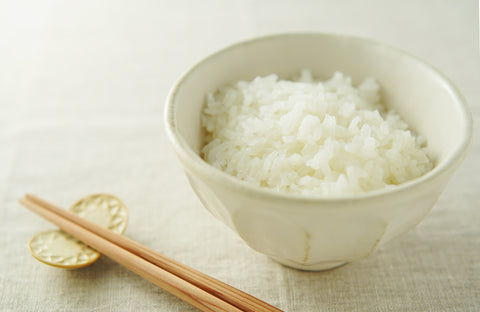
While whole-grain brown rice might be considered “healthier” by some food enthusiasts outside Japan, short-grain white rice is a centerpiece of the Japanese diet. It forms the carbohydrate base of most meals.
Fish and Seafood
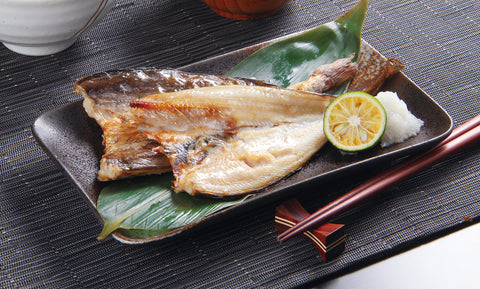
Japan's cuisine offers endless ways to enjoy seafood. From fatty salmon to delicate whitefish, squid to octopus, shrimp to crab and more, Japan is a seafood lover's paradise. Omega-3 fatty acids found in fish offer numerous health benefits.
Fermented Foods
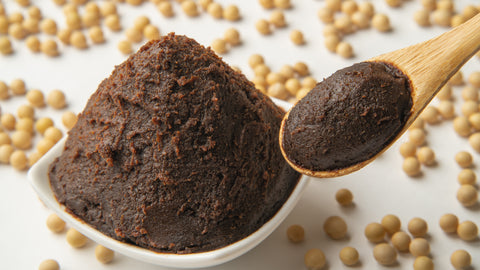
A surprising star! Miso, natto and various pickles bring gut-healthy probiotics along with bursts of umami flavor.
Green Tea
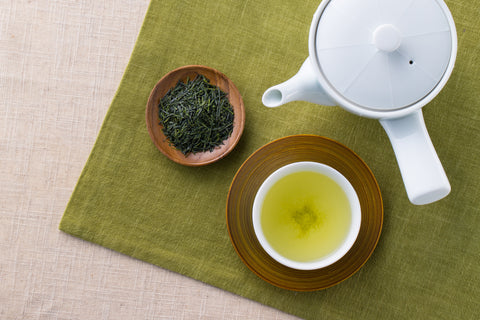
Green tea is Japan's beverage of choice. Rich in antioxidants, it's enjoyed throughout the day, both hot and cold. It’s seen as having a “cleansing” nature, again offering balance to contrast fats and/or strong flavors.
These components, along with a focus on fresh, minimally processed ingredients, create a dietary pattern that's undeniably good for you.
Pros/Benefits Of The Japanese Diet
The health benefits associated with the Japanese diet are impressive.
This style of eating is characterized by being low in saturated fat, processed foods and refined sugars. At the same time, the Japanese diet is rich in nutrients, fiber and antioxidants.
These factors contribute to the high life expectancy in Japan and the nation's relatively low rates of heart disease, type 2 diabetes and certain types of cancer. Studies have linked the traditional Japanese diet to a reduced risk of obesity and even improved cognitive function in older adults.
One of the strengths of the Japanese diet is its emphasis on whole, minimally processed foods. This naturally increases the intake of beneficial vitamins, minerals and phytonutrients – while limiting the harmful effects of unhealthy fats and excessive added sugar.
Additionally, the traditional Japanese diet encourages mindful eating, with smaller portions and an emphasis on savoring flavors, which can help with maintaining a healthy weight.
Potential Downsides Of The Japanese Diet
While the Japanese diet offers numerous benefits, it's important to consider some potential drawbacks.
One concern is the relatively high sodium intake, mostly due to the frequency of soy sauce, miso and pickled foods. For individuals sensitive to sodium or those with high blood pressure, this might be an area to monitor.
Additionally, depending on where you live, access to the full range of Japanese ingredients may be limited or expensive. However, you can adapt the core principles of the Japanese diet without needing every authentic ingredient.
Finally, some may find the traditional Japanese diet lacking in variety, particularly compared to the vast range of cuisines and food options available in many Western countries.
The Japanese Diet vs Other Diets
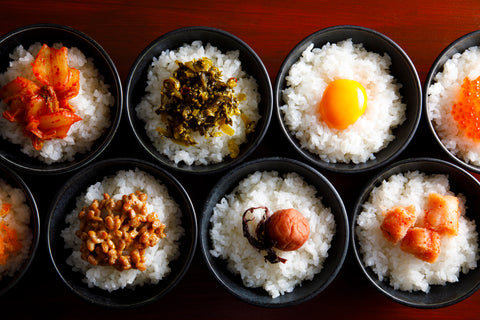
The Japanese diet shares some interesting similarities with other well-regarded dietary patterns like the Mediterranean diet.
Both emphasize whole foods, lean protein sources like fish and an abundance of vegetables. They also share a focus on moderate portions and healthy fats like those found in olive oil (in the Mediterranean diet) and fish (in the Japanese diet). Additionally, both diets encourage mindful eating practices that prioritize enjoying fresh, flavorful ingredients.
However, there are some key distinctions between the two. The Japanese diet generally incorporates more fermented foods like miso and natto, while the Mediterranean diet leans towards dairy products like yogurt and cheese. The Mediterranean diet might also include a wider variety of whole grains beyond rice.
Ultimately, both diets offer a healthy approach to eating, and you can find inspiration from each to create a well-rounded dietary pattern that suits your preferences.
Of course, there are a wide variety of diets in the world, and many of the cultures who have traditionally followed these diets are said to be in reasonably good health. It’s not our place to say what’s best for whom. What we can say is that the Japanese diet, to this day, offers both high nutrition and tremendous taste.
Are Japanese People Healthy?
Japan boasts some of the world's highest life expectancy rates, with a significant portion of the population living well into their 80s and even 90s.
While genetics certainly play a role, many experts attribute much of this longevity to the traditional Japanese diet – one that promotes healthy aging through its emphasis on whole foods and balanced nutrition.
It's important to remember that diet is just one factor influencing health. Physical activity, social connections and access to quality healthcare all contribute to overall well-being. However, the Japanese diet offers a solid foundation for a healthy lifestyle.
How To Follow The Japanese Diet At Home
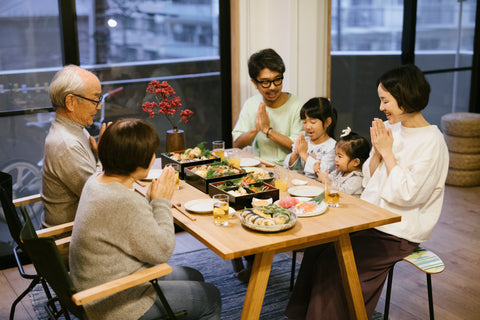
The beauty of the Japanese diet is its adaptability. You don't need a complete overhaul of your eating habits to reap some of its benefits.
Why not start by checking out our wide array of Japanese recipes, where you can find out how to make many of the dishes that have made the Japanese Diet what it is today.
Here are some tips to incorporate Japanese dietary principles into your own life:
- Plan meals around fresh, seasonal ingredients. Visit your local farmer's market or explore the produce section of your grocery store with a focus on seasonal offerings.
- Embrace vegetables! Explore the diverse world of Japanese vegetables and incorporate them into your meals in various ways.
- Incorporate fish more regularly. Aim for a few servings of fish per week, experimenting with different cooking methods like grilling, baking or pan-frying.
- Don't be afraid to experiment with fermented foods. Start with small portions of miso paste in soups or dressings, or try a taste of natto (fermented soybeans) if you're feeling adventurous.
- Focus on presentation and mindful eating. Plate your meals with intention, using smaller plates and taking the time to savor each bite.
- Substitute ingredients where necessary. Can't find the exact ingredient you’re looking for? Swapping out for another variety will work just fine. The core principles are more important than strict adherence to specific ingredients.
Incorporating these practices doesn't have to be an all-or-nothing approach. Start by making small changes and gradually integrate more elements of Japanese cuisine into your routine. Your taste buds and your body will thank you!
Embracing The Japanese Diet
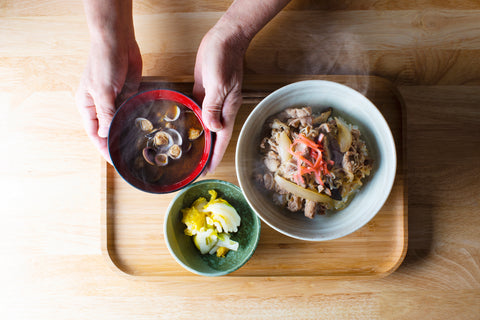
The Japanese diet offers a delicious exploration of a cuisine that prioritizes both health and enjoyment.
Its emphasis on whole foods, balance and mindful eating offers valuable lessons we can all apply to our own lives. By incorporating quality ingredients, diverse flavors and a focus on appreciating every meal, we can nourish our bodies and experience the joy of eating well.
Whether it's trying a new recipe for miso soup, experimenting with grilling fish or simply taking time to savor a beautifully plated snack, there's always a way to add a touch of Japanese diet inspiration to your day.


0 comments